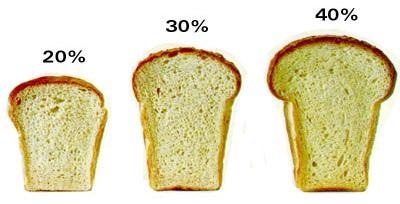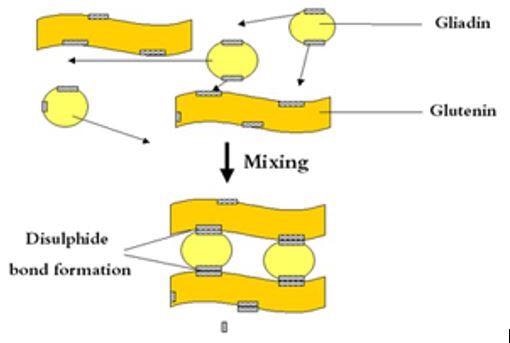The Perten Glutomatic® 200 System from PerkinElmer is the global standard for identifying the quantity and quality of gluten. The gluten content and strength of the flour govern the quality of the end product while baking bread and making pasta or noodles.

Figure 1. Wet gluten quantity. Image Credit: PerkinElmer Food Safety and Quality
The quantity and quality of gluten in the flour used for making cookies, bread, pasta and crackers play a major role in the final product. The bread loafs depicted in Figure 1 clearly demonstrates that the wet gluten quantity of the flour has a strong impact on bread volume. The Perten Glutomatic System can be used to determine the baking quality of wheat and flour.
The Perten Glutomatic System comes with:
- Perten Glutomatic 2000
- Glutork 2020
- Gluten Index Centrifuge 2010
Features and Benefits
The Perten Glutomatic System has been used across the world by thousands of grain traders, breeders, flour millers and manufacturers of noodle/pasta, who benefit from its features.
- Gluten quantity and quality can be identified — Users can improve the quality of their finished products by ensuring that their raw materials comply with gluten specifications. The higher the wet gluten content, the higher the bread volumes.
- Quick analysis — A complete test needs only less than 10 minutes.
- User-friendly — The Perten Glutomatic System is an automated, easy-to-use instrument with a wide touchscreen that guides the operator through the analysis. The system can be operated even by non-technical personnel.
- Determines true gluten — Although gluten is generally associated with protein, in several, a wheat type would have a high protein content but very weak or no gluten. The Perten Glutomatic is the only means to identify this.
- Official world standard — Gluten quantity and quality determined by the Perten Glutomatic System are typically specified for international wheat and flour trade. Users should ensure that the buyer and seller agree to the use of the international standard. The Perten Glutomatic System is approved based on the following standards:
- ISO 21415-2, 21415-4
- AACC 38-12.02
- IRAM 15864
- ICC/No. 137/1, 155 & 158
- CCAT Method 13
- GBT 5506.2, 5506.4
- For flour and grain — The use of the Perten Glutomatic avoids the need to produce flour to identify the gluten characteristics for a wheat type. This saves time and costs because the Gluten Index method works both for ground wheat and for flour.
- Connectable — The Perten Glutomatic is equipped with communication ports for the Centrifuge 2010, a balance and for connection with LIMS/PC.
Applications
The quality of dough-based products like bread, noodles or pasta dependents very much on the quantity and quality of the gluten in the flour. Thus, everyone in the wheat chain, right from breeder to baker, benefit from the analysis and control of gluten properties using the Perten Glutomatic System.
- Breeding — Breeders can measure the functional properties of protein at an early stage, without the need to extract flour, thus selecting the suitable classes of wheat for further breeding and refinement.
- Grain trading and handling — The ease of handling and the speed of the method allow users to classify the incoming wheat depending on its gluten quantity and quality, which is crucial for optimizing trade margins and supplying products ideal for different end-use purposes.
- Flour milling — Millers can blend flour so that it satisfies the demands of end-users without selling high-quality products at a low price, thus improving operating margins. Millers can use the Gluten Index, the Wet Gluten Content, and the Falling Number analysis results to quickly predict the final baking quality, thereby minimizing the need for test baking.
- Baking — The properties and structure of gluten are vital to:
- Retain gas while fermenting and baking
- Make an elastic dough
- Enable expansion
- Carry expansion
- Retain the shape of the loaf
- Durum and pasta — In crop reports across the world, the Gluten Index is reported as a vital quality indicator. Gluten has a high impact while manufacturing pasta:
- Forming non-sticky dough
- Obtaining preferred processing characteristics
- Achieving products with preferred cooking characteristics
- Maintaining cooking stability and firmness
Baking quality is governed by both starch and protein characteristics. Therefore, a combination of results from the Perten Glutomatic and Perten Falling Number® tests can be used to predict the baking quality.
Bakeries can use the information related to the gluten quality and quantity to use the most economical grade of flour while satisfying end-user quality. Considerable savings can be ensured by increasing the use of high-quality flour and reducing the addition of costly vital gluten results.
About Gluten
Gluten is the functional component of protein and governs various dough and processing characteristics of wheat and wheat flour.
Gluten is made of two proteins: “Glutenin” and “Gliadin.” Gluten forms only when the dough is made. Therefore, it is not possible to identify gluten in wheat without making a dough.
Gluten formation requires flour, water and energy from kneading. As shown in Figure 2, the end result is the formation of a disulfide bond between the glutenin and the gliadin.

Figure 2. Image Credit: PerkinElmer Food Safety and Quality
Analysis of the protein content is purely quantitative and may or may not be indicative of protein quality. Although protein content and gluten content are correlated, at times, the protein content may not be indicative of quality due to:
- Yearly growing variation
- Variable growing conditions
- Wheat or flour blends
- Wheat varietal variation
- Heat damage
- Bug damage
- Enzymatic addition
Thus, another set of tests is mandatory when the reported protein content is not indicative of quality under the above-mentioned conditions. The Perten Glutomatic system has been engineered to measure protein quality for the parameters given below:
- Dry gluten content
- Wet gluten content
- Gluten strength by Gluten Index
- Water binding of gluten
Specifications of the Perten Glutomatic System
General
- Net weight: Glutomatic 2000 18 kg / Centrifuge 2010 7 kg / Glutork 2020 2 kg
- Power consumption: Glutomatic 2000 250 VA / Centrifuge 2010 110 VA / Glutork 2020 875 VA
- Power requirements: 115/230 V, 50/60 Hz
- Dimensions (H x D x W) — Glutomatic 2000: 378 x 353 x 288 mm; Centrifuge 2010: 203 x 270 x 224 mm; Glutork 2020: 90 x 255 x 200 mm
- Touchscreen (GM 2000): 7 inches, capacitive
- Interfaces: 3x USB type A, 1x USB type B, 1x micro USB (service only), 1x ethernet connection
- Humidity: 35% – 80% RH, non-condensing
- Ambient temperature: 5 °C to 35 °C
Analysis
- Parameters: Gluten Index, dry gluten content, wet gluten content, water binding in gluten
- Products: Wheat, wheat flour, vital gluten, durum, semolina
Recommended Accessories
For quick and convenient grinding of whole wheat to wheat meal, Laboratory Mill 3100 or 120 can be used.
Research Areas
The Perten Glutomatic 2000 is mainly used in the Food and Agriculture industry.